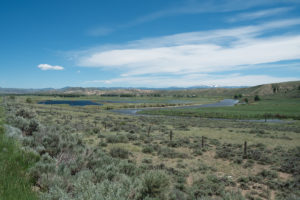One of the main focuses of the class I help teach in the fall, “Contemporary Issues in Water Management“, is the nature and function of “coupled human and natural systems”. (In fact, might say it’s the main focus of the entire UNM Water Resources Program, come to think of it.)
One of the biggest difficulties in dealing with water in the 21st century is figuring out where to draw the boundaries around the problem you’re trying to solve. If you get the boundaries wrong, you end up with externalities (both in the literal economics-jargon sense, and in the broader people-and-things-left-out sense) that lead to terrible solutions. This is what is happening, for example, at the Salton Sea, where a water policy success (conserve water!) has led to an externality failure (Salton Sea shrinks, birds die, and maybe people too!).
The complex nature of these coupled systems, where the scale of human activity can alter watersheds on an unimaginable scale (quite literally unimaginable, at least within the structure of the decision-making process – we always do stuff with impacts decision-makers failed to properly imagine and incorporate).

Colorado River near Kremmling, Colorado, by John Fleck
Writing in High Country News, rancher and fishing guide Paul Bruchez describes a fascinating process of trying to build the institutions needed to fully incorporate the many pieces of one coupled system – the Colorado River Valley around Kremmling, as the river emerges from the rugged headwaters into broad valleys amenable to farming and ranching and fishing and such.
Bruchez describes the coupled nature of this system:
For decades, water utilities on the Front Range have been pumping water from the Upper Colorado, leading to devastating impacts on the health of the river. Lower flows spiked water temperature and silted in the river bottom. This smothered insect life, damaging the river ecosystem and what had been a world-class trout fishery. Agriculture also suffered as river levels dropped. My family and other ranchers in the valley saw irrigation pumps left high and dry as our operations became unsustainable.
So both the natural system and the human system around Kremmling are deeply coupled to urban growth a mountain range away.
One traditional environmental/development politic solution to a problem like this is to try to uncouple by either a) stopping the Front Range diversions, or b) ignoring the problems of diversions and screwing the river valley. Then we have a big fight.
Bruchez describes a different approach, the slow and difficult process of building an institutional framework that instead more tightly and mindfully couples the two sides of the divide. Locals, environmental advocates, and big water managers are worked together to restore stuff:
What have I learned from this project? That the interests of ranchers and farmers can align with the interests of conservation groups, state agencies, water providers and other river users. The Colorado River flows through all of our lives. By working together, we can find smart, creative solutions that keep the Colorado healthy and working for all of us.
You should read the whole thing to get a better feel for what they’ve done. It’s a hopeful example.
